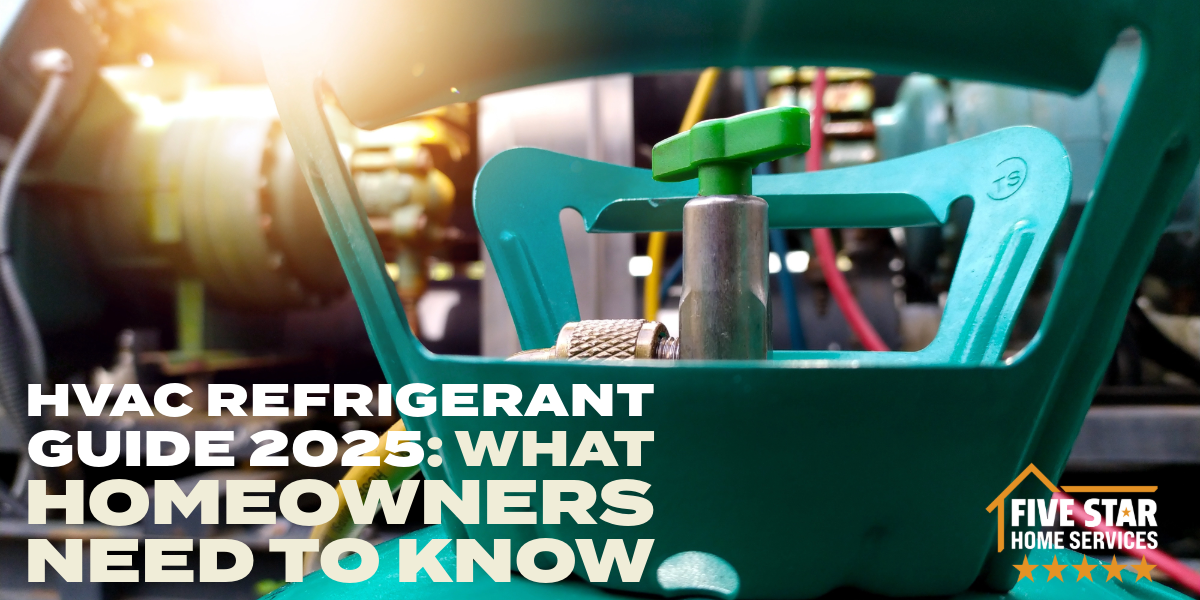Keeping your home cool in the summer relies on HVAC refrigerant. This liquid moves through air conditioners and heat pumps, pulling heat from inside and releasing it outdoors. But not all refrigerants are the same. Over time, new rules and better technology have changed the types of refrigerants used. With new refrigerant standards starting in 2025, it’s more important than ever to know which one your system uses.
What is HVAC Refrigerant and Why Does It Matter?
Refrigerants are what make your air conditioner work. Without them, your system wouldn’t be able to cool your home. Over the years, different types of refrigerants have been used, each with different effects on energy use, cost, and the environment. As older refrigerants are replaced with more eco-friendly options, homeowners need to know which type their system uses and whether an upgrade is needed.
If you’re unfamiliar with the changes that are happening in AC refrigerants, don’t worry! Five Star Home Services is your guide to helping you understand what it means and why it matters for you.
What Are the Most Common HVAC Refrigerants?
There have been many changes to refrigerants over the years. Here’s a simple breakdown of the most common refrigerants found in home heating and cooling systems.
1. R-22 (Freon) – No Longer Used
What is R-22?
R-22, also known as Freon, was the main refrigerant in home air conditioners for many years.
Why was R-22 banned?
This refrigerant type contains chlorine, which harms the earth’s ozone layer. The U.S. stopped producing and importing R-22 in 2020, although some recycled R-22 is still available. Fortunately, there are ways how to tell if your system runs on R-22 and what steps to take if it does.
Do they still use R-22?
If your air conditioner was installed before 2010, it probably runs on R-22. Since R-22 is no longer made, it has become expensive and hard to find. This makes repairs costly if your system needs more refrigerant. If your system still uses R-22, it’s a good idea to start planning for a replacement with a newer, more efficient model.
2. R-410A (Puron) – Being Phased Out
What is R-410A?
R-410A, or Puron, replaced R-22 and became the most common refrigerant in home cooling systems.
Why is R-410A being replaced?
- While better for the ozone layer, it still has a high environmental impact due to its greenhouse gas emissions.
- Beginning in 2025, manufacturers will stop making systems that run on R-410A and switch to greener alternatives like R-32 and R-454B.
Should you keep a system with R-410A?
If your system uses R-410A, you can still get refrigerant for repairs, but over time, it may become more expensive. Systems designed for R-410A cannot use the new refrigerants, so when your unit reaches the end of its lifespan, you will need to install a model that supports R-32 or R-454B. If your system is already breaking down often, replacing it sooner rather than later could save you money.
3. R-32 – A More Efficient HVAC Refrigerant
What is R-32?
R-32 is a newer refrigerant that is replacing R-410A because it is better for the environment and more energy-efficient.
Why is R-32 a better option?
- Less impact on global warming – R-32 has a 68 percent lower environmental footprint than R-410A.
- Uses less refrigerant – Systems that use R-32 require 30 percent less refrigerant than R-410A models.
- More energy-efficient – It helps lower cooling costs because it transfers heat more effectively.
Is R-32 a good choice for your home?
R-32 is a great option for those looking for a more efficient and eco-friendly HVAC system. If you are upgrading your unit, you may find that some models now run on R-32. However, not all systems are compatible with this refrigerant, so it’s important to check before making a decision.
4. R-454B (Puron Advance) – The Future Standard
What is R-454B?
R-454B, also called Puron Advance, is the refrigerant that will replace R-410A starting in 2025.
Why is R-454B the best choice?
- Safer for the environment – It has a 78 percent lower environmental impact than R-410A.
- Does not harm the ozone layer – Unlike R-22, R-454B does not contain chlorine.
- Meets new government standards – HVAC manufacturers are switching to R-454B to follow new energy efficiency rules.
Why should you consider R-454B?
If you’re replacing your HVAC system, choosing one that uses R-454B is the best way to future-proof your home. Since this refrigerant will soon be the industry standard, switching now will help you stay ahead of regulations and avoid extra costs later. Five Star Home Services offers energy-efficient systems that support R-454B, so you can upgrade with confidence.
How to Identify the HVAC Refrigerant in Your System
To learn what refrigerant your system currently uses, check the sticker or plate on your unit’s compressor or evaporator. These labels often specify the refrigerant type and other important details about your system. It is important to use the correct refrigerant—mismatched refrigerants can cause damage to your AC system and void warranties.
If you still aren’t sure which refrigerant your HVAC system uses, just call Five Star!
How to Check Refrigerant Levels in HVAC Systems
Your HVAC system needs the right amount of HVAC refrigerant to cool or heat your home. Low refrigerant can cause poor cooling, higher energy bills, and system damage. Here’s how to check if your refrigerant levels are low.
1. Watch for Signs of Low Refrigerant
Look for warning signs before checking the system. If your air conditioner blows warm air, runs longer than usual, or causes higher energy bills, refrigerant may be low. Ice on refrigerant lines or hissing sounds could mean there’s a leak.
2. Check for a Refrigerant Sight Glass
Some systems have a sight glass near the refrigerant line, allowing you to check the liquid inside. Smooth, clear movement usually means the refrigerant level is fine. However, bubbles or foam may indicate low refrigerant or a possible leak. Not all systems include a sight glass, so if yours doesn’t, proceed to the next step.
3. Look for Ice on the Refrigerant Lines
Find the copper refrigerant lines outside. If the larger line has frost or ice, HVAC refrigerant levels may be too low. Ice on the coil inside the unit is also a warning sign. Turn off your system to avoid damage and call a professional.
4. Check System Pressure With a Gauge (For Professionals Only)
HVAC technicians use a manifold gauge to measure refrigerant pressure. A professional attaches the gauge to the service valves and checks if pressure is within the correct range. Low pressure often means a leak or low refrigerant.
5. Call a Five Star HVAC Professional for an Inspection
If you suspect low refrigerant, call a licensed HVAC technician. A professional will check for leaks, refill refrigerant, and ensure your system runs efficiently. Refrigerant doesn’t run out naturally, so low levels usually mean a leak.
However, refrigerant issues aren’t the only reason an air conditioner may struggle to perform. If your system isn’t cooling properly, there are AC troubleshooting steps to rule out other possible problems before inspecting refrigerant levels. Here’s how to check if your refrigerant is low.
Environmental Impacts and Local Regulations
Older refrigerants like R-22 and R-410A are being phased out because they harm the environment. These chemicals contribute to ozone depletion and global warming. New laws at both the federal and state levels are phasing out HFC refrigerants and moving toward more eco-friendly options like R-32 and R-454B.
Following these new regulations is important for homeowners in Columbus, Dayton, and Cincinnati. Working with a licensed HVAC technician ensures your system meets local guidelines and runs safely.
Things to Consider When Choosing an HVAC Refrigerant
Choosing the right HVAC refrigerant can impact your system’s performance, energy use, and future costs. Keep these factors in mind:
- System Compatibility – Always use the refrigerant type recommended by the manufacturer.
- Energy Efficiency – Refrigerants like R-32 cool your home while using less energy.
- Environmental Impact – Lower GWP (Global Warming Potential) refrigerants help reduce pollution.
- Future-Proofing – New refrigerants like R-454B follow upcoming regulations and ensure long-term compliance.
If you’re considering an upgrade, our AC buying guide walks you through what to look for in a new cooling system.
What’s Next for HVAC Refrigerants?
The HVAC industry is shifting toward greener, more efficient refrigerants. New options like R-32 and R-454B offer better cooling performance with less environmental impact. At Five Star Home Services, we help homeowners transition to these new solutions.
Many top HVAC brands are investing in refrigerants that meet stricter environmental standards while still delivering strong performance and lower energy costs. Our advanced systems also include smart technology, allowing homeowners to monitor and adjust their cooling systems in real time.
Best Practices for Handling Refrigerants
Taking care of your HVAC refrigerant helps extend the life of your system and keeps it running smoothly. Here’s what homeowners should do:
- Schedule Inspections – Routine HVAC checkups ensure your system is working properly.
- Prevent Leaks – A refrigerant leak can lower efficiency and harm the environment.
- Work with Licensed Technicians – Certified HVAC professionals, like our team at Five Star, have the training needed to handle refrigerants safely.
- Plan Ahead – With refrigerant phase-outs happening, staying informed can help you avoid costly repairs or replacements later.
For more ways to keep your HVAC system running efficiently, follow these HVAC maintenance best practices to avoid expensive repairs and extend its lifespan.
Final Thoughts on the 2025 Refrigerant Changes
At Five Star Home Services, we believe knowledge is power. Knowing about HVAC refrigerants helps you make smart choices for your home. Whether you’re maintaining an older system or upgrading to R-454B, staying informed ensures better efficiency and long-term savings.
If you live in Columbus, Dayton, Cincinnati, or nearby areas, our expert HVAC team can help you transition to newer refrigerants smoothly.
Need help finding out what HVAC refrigerant your system uses? Considering an upgrade? Call (833) 405-8009 today. The right refrigerant choice now means better efficiency, sustainability, and home comfort for years to come.
(Gage Rhodus is an HVAC comfort advisor for Five Star Home Services. He has been with the company for five years and has been doing HVAC work for about 10 years, including installation, service and sales. What he loves most about the industry is being able to meet the community and serve them at the highest level! Gage and his wife Caity have three children: Two boys, Theo and Cooper, and one girl, Rosie. He enjoys writing and playing music as well as fitness.)


